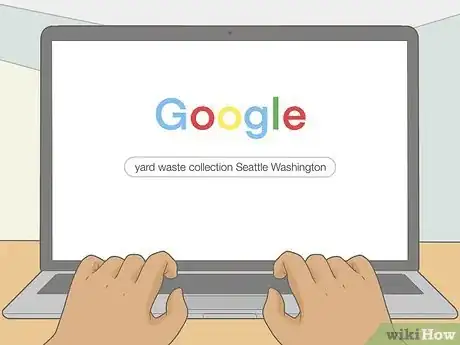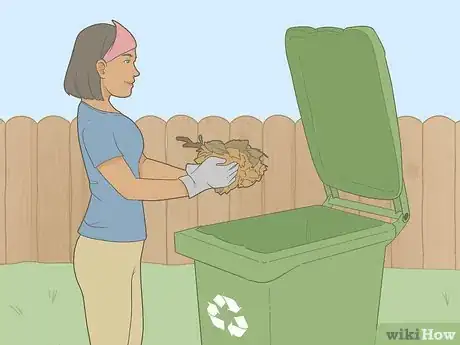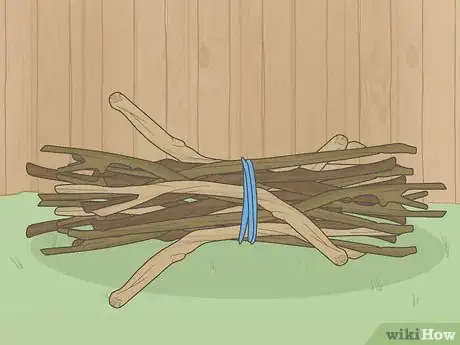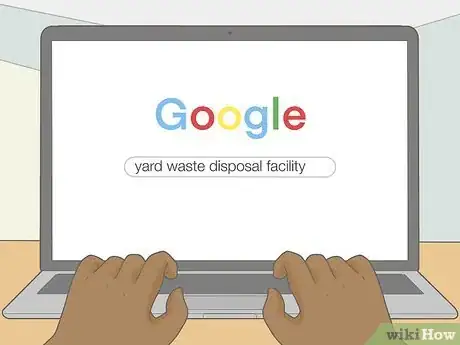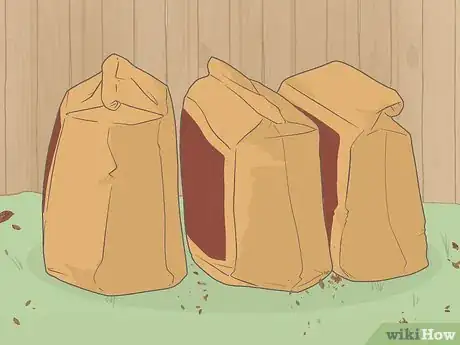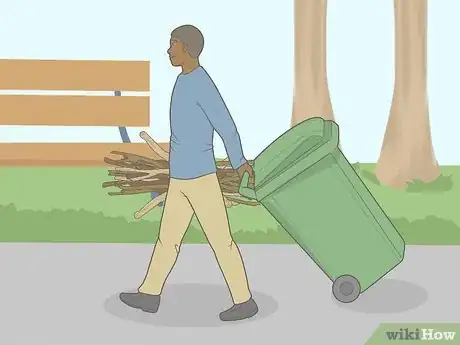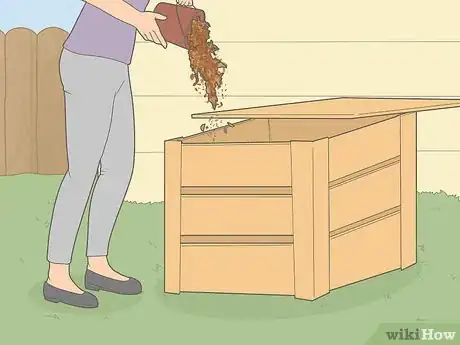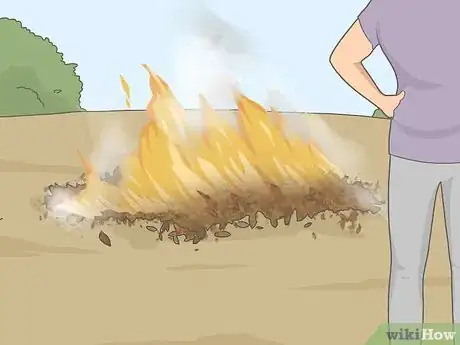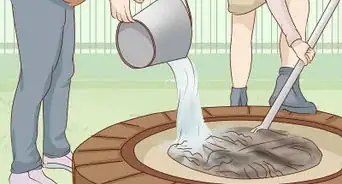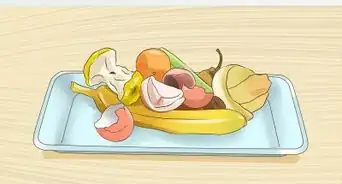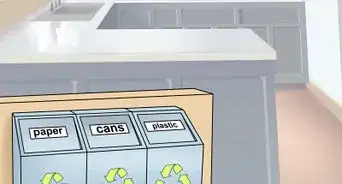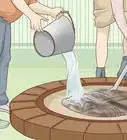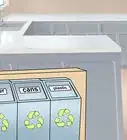This article was co-authored by Grant Wallace. Grant Wallace is a Landscaper and Owner of Grantlanta Lawn in Atlanta, Georgia. With over seven years of experience, he specializes in lawn maintenance and landscape installation. In 2012, he earned his BA from the University of West Georgia. Grant has been profiled in Shoutout Atlanta, Canvas Rebel, and Voyage ATL.
There are 7 references cited in this article, which can be found at the bottom of the page.
This article has been viewed 26,869 times.
Yard waste like leaves and branches can pile up pretty quickly. Luckily, if you live in any urban or semi-urban area, you probably have a local collection service that will pick up your leaves and branches. There are also many types of facilities where you can drop off yard waste. Either way, make sure to follow the guidelines for getting your leaves and branches ready for pickup or drop-off. You can always try recycling some of your leaves into mulch or compost that will feed your lawn and garden, too!
Steps
Using a Local Curbside Pickup Service
-
1Look on your city’s website for yard waste pickup times and rules. Most towns and cities have a curbside yard waste pickup service, but every community has its own rules and regulations about what they will pick up, when they pick it up, and how you have to leave it. Go to your local government’s website and find the page about yard waste collection, then read all the information before you set out leaves and branches for pickup.[1]
- If you don’t know what your city’s website is, you can do a quick google search with keywords like “yard waste collection” or “yard waste pickup” and the name of where you live. For example, “yard waste collection Seattle Washington.”
- Many communities distribute yard waste bins along with recycling bins and garbage bins, which makes it easy to put your leaves and branches out for collection.
- If you do have a yard waste bin, it’s still important to read up on local guidelines about what you can and can’t put in the bin, what days and times the city picks up yard waste, and other important info.
-
2Put leaves and small branches in a yard waste bin or a paper lawn and leaf bag. Throw the leaves and branches you want to dispose of into your city-provided yard waste bin, if you have one. Use paper lawn and leaf bags if you don’t have a yard waste bin or if your yard waste bin is full and you have additional leaves and branches to dispose of.[2]
- You can purchase paper lawn and leaf bags online or at any home improvement center. Department stores and garden centers also usually sell them.
- Some communities might also allow you to put leaves and branches in a container labeled “yard waste only.” This is a piece of information you would be able to find on your local government’s website.
- If any small branches are too gnarly to fit neatly into your yard waste bin or lawn and leaf bags, you can saw them up or break them apart until they fit.
Tip: Some cities offer a fall curbside leaf vacuuming service, in which case you would just have to put your leaves into neat piles by the side of the road and the city will come by to vacuum them up. You can find out if this is available in your area on your local government’s website.[3]
Advertisement -
3Bundle large branches together with twine or rope. Look on your city’s website to find out the maximum allowed dimensions for bundled branches. Gather large branches together into neat bundles that are no bigger than the permitted dimensions, then tie a piece of twine or rope around the bundles to secure the branches together.[4]
- For example, you might only be permitted to put out bundles that are up to 4 ft (1.2 m) long and 2 ft (0.61 m) wide.
- There might also be limitations on how big the branches can be, such as up to 4 in (10 cm) in diameter.
- Note that branches and other yard waste generated by landscapers are usually not allowed to be left for curbside pickup. In other words, if you hire a landscaper to trim your trees and rake leaves, they are responsible for disposing of the waste.
-
4Set your yard waste by the curb before the designated day and time for pickup. Double-check what days and times your city collects yard waste. Place your yard waste bin, paper lawn and leaf bags, and bundles of branches neatly by the curb where you normally place your garbage and recycling before the designated time, so it will get picked up by the city’s collection service.[5]
- For example, your city’s yard waste collection time might be between 7:00 a.m. and 9:00 a.m. on Mondays. In this case, you would have to put out your leaves and branches on Sunday night or before 7:00 a.m. on Monday.
- Make sure that your yard waste is not obstructing bike lanes, sidewalks, or traffic.
- If you miss the collection time for some reason, wait until the next pickup day to put your yard waste out. Don’t just leave it sitting out for days until the next time the city comes around to collect it.
Hauling Leaves and Branches Away
-
1Search online for a local yard waste drop-off facility. Google keywords like “yard waste drop-off site,” “yard waste disposal facility,” or “composting center” and the name of where you live to find somewhere you can haul your leaves and branches to. Note the locations of each facility, the times they accept drop-offs, and what materials they do and do not accept.[6]
- This is an alternative to putting your yard waste out for collection if you need to get rid of a large amount of yard waste, if there is no curbside pickup service in your area, or if you are a professional landscaper who is responsible for disposing of the yard waste you generate.
- You might find a variety of facilities in your area that accept leaves and branches, such as composting depots, dumps, recycling facilities, and even community gardens. You can choose the site that is most convenient to you.
-
2Cut branches to the sizes permitted by the facility you plan to drop them off at. Use a saw or large garden shears to trim large branches down to manageable sizes. Make sure they fall within the size limitations allowed by the drop-off site you will take them too.[7]
- For example, a facility might only accept branches that are less than 3 ft (0.91 m) in length and under 4 in (10 cm) in diameter.
-
3Place leaves into paper lawn and leaf bags. Most drop-off facilities require you to deliver leaves and plant trimmings inside paper lawn and leaf bags. Fill each bag up as much as possible to minimize the number of bags you use.[8]
- Yard waste recycling facilities usually won’t accept leaves if they are inside plastic bags.
Tip: Though many yard waste drop-off sites are free, some might charge a small fee. If this is the case, they might charge something like $1.50 per bag of leaves. Some places just charge by weight. You can find info about fees on a facility’s website or by calling the place up and asking an employee.
-
4Take your leaves and branches to the drop-off facility during their open hours. Double-check the hours that your chosen facility is open on the day you plan to drop off your yard waste. Load the leaves and branches into a vehicle and drive them to the facility.[9]
- These facilities usually have pretty standard hours, such as from 7:00 a.m to 5:00 p.m. on weekdays, shorter hours on Saturdays, and closed on Sundays and holidays.
-
5Hire someone to haul your yard waste away if you don’t have a proper vehicle. Contract a landscaper, a waste hauler, or just someone with a pickup truck to come take your yard waste to a drop-off facility if you don’t have a vehicle that you can fit your leaves and branches into. Schedule a time for them to come pick up the yard waste and take it away to properly dispose of it at a facility.[10]
- There are lots of junk hauling services that will take away pretty much anything you can imagine. You can find these services by Googling something like “yard waste hauling service” or “junk haulers” and the name of where you live.
Trying Other Disposal Techniques
-
1Mow over leaves to mulch them into your lawn. Spread leaves out over your lawn using a rake or leave them where they have fallen off of trees. Run a lawnmower over them to cut them up into fine mulch that will decompose into the soil under your lawn and provide additional nutrients.[11]
- Make sure there are no branches or large pieces of debris on your lawn before you start mowing over the leaves.
-
2Put layers of leaves in a composting bin to turn them into useful compost. Layer leaves into a backyard composter along with kitchen scraps, lawn trimmings, and other organic matter. They will decompose and turn into compost that you can use for gardening projects.[12]
- If you don’t have a composting bin, you can build one on a free afternoon. Composting will cut down on the amount of yard waste you have to put out for collection or haul away, not to mention it’s useful and great for the environment!
-
3Burn leaves and branches if it is permitted in your area and safe to do so. Check local bylaws to find out if burning yard waste is permitted in your area. Create piles of yard waste in large, open areas, away from anything flammable like overhanging trees or buildings, and set your leaves and branches on fire to dispose of them.[13]
- Burning leaves and branches emits pollutants, and there’s always a risk of accidentally spreading a fire, so use this technique as a last resort.
- Try to recycle as much as you can by turning leaves into mulch or compost, then burn whatever you can’t use.
- If you live in a rural area without a yard waste collection service or a nearby drop-off facility, this might be the most practical method to get rid of your leaves and branches.
Tip: You could also cut up large branches, that are too large for the city to pick up or to drop off somewhere, into firewood that you can use in your home’s fireplace or give away to someone who has a fireplace.
Expert Interview
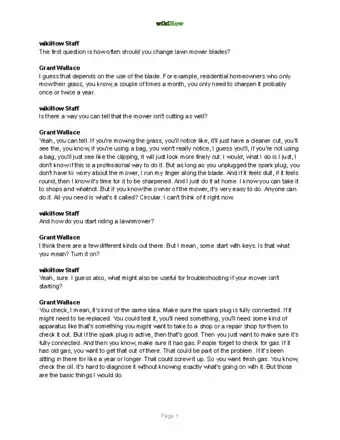
Thanks for reading our article! If you'd like to learn more about disposing of tree branches, check out our in-depth interview with Grant Wallace.
References
- ↑ https://www2.montgomerycountymd.gov/dephowdoi/material.aspx?tag=yard-trim&material_key=72
- ↑ https://www1.nyc.gov/assets/dsny/site/services/food-scraps-and-yard-waste-page/leaf-and-yard-waste
- ↑ https://www.eugene-or.gov/613/Leaf-Disposal-Safety-Tips
- ↑ https://www1.nyc.gov/assets/dsny/site/services/food-scraps-and-yard-waste-page/leaf-and-yard-waste
- ↑ https://www.peelregion.ca/waste/yard-waste/
- ↑ https://www.london.ca/residents/Garbage-Recycling/Yard-Materials/Pages/Yard-Material-Collection.aspx
- ↑ https://www.london.ca/residents/Garbage-Recycling/Recycling/Pages/Depots.aspx
- ↑ https://www.london.ca/residents/Garbage-Recycling/Recycling/Pages/Depots.aspx
- ↑ https://www.london.ca/residents/Garbage-Recycling/Recycling/Pages/Depots.aspx
- ↑ https://www.popularmechanics.com/home/outdoor-projects/how-to/g2557/how-to-dispose-of-yard-waste-legally/
- ↑ https://www.london.ca/residents/Garbage-Recycling/Yard-Materials/Pages/Yard-Material-Collection.aspx
- ↑ https://www.london.ca/residents/Garbage-Recycling/Yard-Materials/Pages/Yard-Material-Collection.aspx
- ↑ https://www.popularmechanics.com/home/outdoor-projects/how-to/g2557/how-to-dispose-of-yard-waste-legally/
Expert Q&A
-
QuestionCan you mulch leaves with a regular mower?
 Grant WallaceGrant Wallace is a Landscaper and Owner of Grantlanta Lawn in Atlanta, Georgia. With over seven years of experience, he specializes in lawn maintenance and landscape installation. In 2012, he earned his BA from the University of West Georgia. Grant has been profiled in Shoutout Atlanta, Canvas Rebel, and Voyage ATL.
Grant WallaceGrant Wallace is a Landscaper and Owner of Grantlanta Lawn in Atlanta, Georgia. With over seven years of experience, he specializes in lawn maintenance and landscape installation. In 2012, he earned his BA from the University of West Georgia. Grant has been profiled in Shoutout Atlanta, Canvas Rebel, and Voyage ATL.
Landscaper Definitely—just make sure that the leaves are really dry and crisp beforehand. Once the leaves are crushed into fine dust, use a leaf blower to spread the dust throughout your yard of plant beds. The next it rains, the leaf dust will soak into the earth, which is free fertilizer for your grass. If you have too much mulch leftover, feel free to bag it up.
Definitely—just make sure that the leaves are really dry and crisp beforehand. Once the leaves are crushed into fine dust, use a leaf blower to spread the dust throughout your yard of plant beds. The next it rains, the leaf dust will soak into the earth, which is free fertilizer for your grass. If you have too much mulch leftover, feel free to bag it up.
Warnings
- Clean up any branches and other debris from your lawn before you mow over leaves to turn them into mulch.⧼thumbs_response⧽
- If you have to burn your yard waste, make sure to do it in an open area, well away from anything flammable that the fire could spread to. Keep any eye on the fire to make sure it doesn’t get out of hand.⧼thumbs_response⧽
Things You’ll Need
Using a Local Curbside Pickup Service
- Paper lawn and leaf bags
- Yard waste bin
- Twine or rope
Hauling Leaves and Branches Away
- Paper lawn and leaf bags
- Vehicle
Trying Other Disposal Techniques
- Lawnmower
- Composting bin
